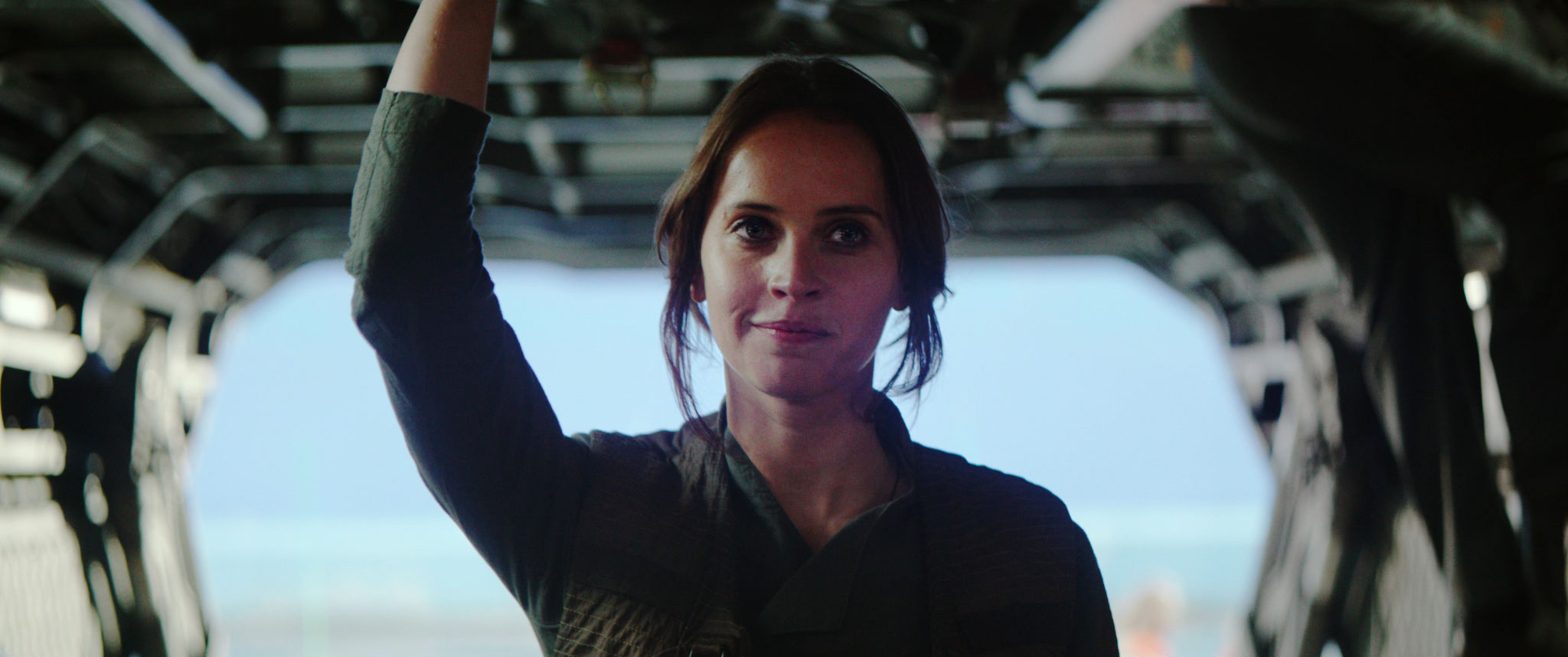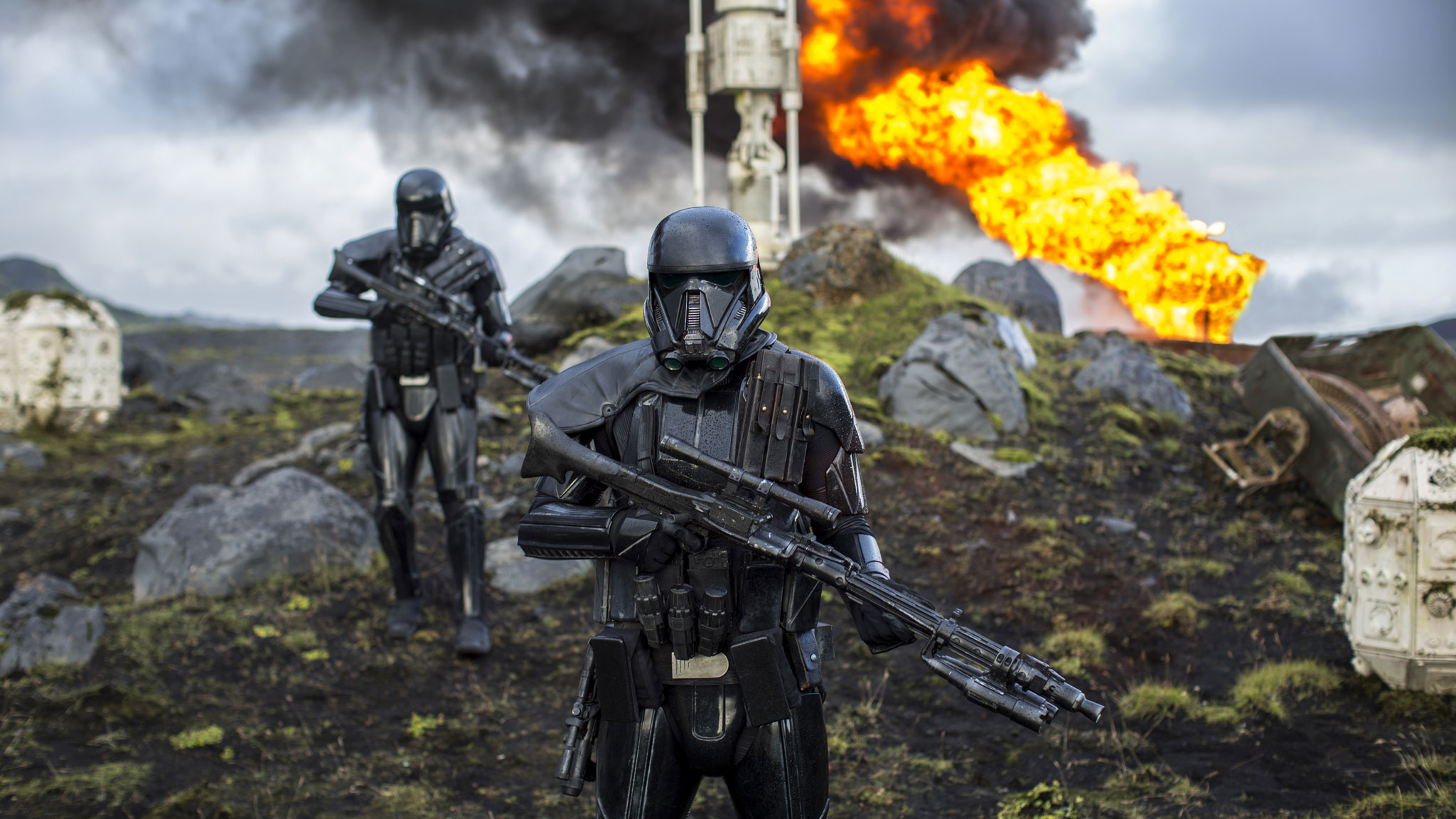Alexa 65 and the Film Look, Bringing Tarkin Back, and ... Larry Mullen Jr.?
The room was filled close to capacity last week for an afternoon NAB Super Session, co-sponsored by the Motion Picture Sound Editors, with key members of the production and post-production team on Rogue One: A Star Wars Story. VFX supervisor, executive producer, and co-writer John Knoll, ILM Animation Supervisor Hal Hickel, and Skywalker Sound Supervising Sound Editor and Sound Designer Matthew Wood all spoke about various techniques that went into the film’s revisitation of the pre-Episode IV Star Wars universe.
The Film Look
Knoll said he knew from the start that he would prefer the film be shot on digital, but director Gareth Edwards and cinematographer Greig Fraser weren’t necessarily on board from the beginning. “Gareth wanted it to look beautiful,” Knoll recalled. “I suggested we take a digital image from the Alexa, work on it in linear space, and output it with the film curve. We ran tests to check the lens flares and highlights.”
Knoll shared some of those tests on the big projection screens in the conference hall. The way the digital image handled highlights wasn’t exactly like film — but it was close enough. In the end, Rogue One shot with the ARRI Alexa 65 but applied an output curve that emulated Kodak 500T 5230 film stock, which Fraser had used to shoot the 2012 Andrew Dominik crime film Killing Them Softly (2012).
Virtual Sets
Another area where fairly extensive testing was performed was virtual sets. Knoll knew they could save money, but wanted to make sure they looked photoreal on screen. Two of his experimental visual sets — the Death Star’s control room and a corridor in the rebel blockade runner — ended up never being used. A scene meant to be staged on a third digital set, depicting a hangar on the Death Star, was shot but subsequently cut from the film.
“It did make everyone comfortable with the idea that we could make set extensions that would work as well as reality,” Knoll said. In the end, the strategy was to deploy simple theatrical flats on the soundstage for shorter scenes, in which they could be replaced and/or embellished with digital textures in post.
Digital set extensions were also used for shots of the Erso homestead, which were photographed with just a handful of physical props in Iceland that were built out to full sets in post.
Lighting with LED Screens
Rogue One also made heavy use of LED screens to generate light and create other visual effects on set. “We used 9mm dot-pitch displays to get some [VFX] shots in camera,” Knoll explained. “Greig lit the set very differently than he would have with green screens. He mostly used the light coming from the screen to illuminate the actors…. LED screens can get realistic results in very tricky lighting situations.”
And, Knoll said, when the primary source of light is being cast by an LED display, you can change your lighting set-up on the fly just by changing the images on screen. The screens were actually bright enough, he noted, that the brightest portions generated lens flares.
In response to a question from the audience, Knoll said that LED displays didn’t really generate moiré patterns despite their relatively large dot pitch because they were usually out of focus behind the actors. “Greig was shooting with the Alexa 65, mostly wide open, so moiré on those 9mm screens was not an issue,” he said. “We would put a diffuser in front of the screen if it was in focus and replace the image later. Sony’s 1mm [CLEDIS] screens are the future of that kind of work.”
Bringing Them Back to Life
ILM animation supervisor Hal Hickel addressed the much-discussed — and somewhat controversial — use of digital humans to return Grand Moff Tarkin (the late Peter Cushing) and a young Princess Leia (as portrayed by Carrie Fisher back in 1977) to the screen. He said ILM’s recent work on Teenage Mutant Ninja Turtles and Warcraft helped pave the way for Rogue One‘s virtual performances.
“Doing an orc [in Warcraft] is easier than doing a normal human being,” Hickel said. “And doing a recognizable human being is harder still …. Doing digital humans is a long series of failures that, hopefully, ultimately lead to success.”
To play Tarkin, actor Guy Henry performed while wearing a pair of head-mounted cameras to capture his facial performance. Previously, ILM would have used full color cameras with LED lights shining into the actor’s face, but for Rogue One less distracting infrared cameras and infrared light were used. The next step, Hickel said, will be to get rid of the “helmet cam” altogether.
Hickel spent some time discussing what he called the “Likeness vs. Lifeness” trade-off. It turned out that the animators found that this specific task — creating a CG face that both looks photoreal and strongly resembles a well-known actor — sometimes put them at odds with themselves. Techniques that increased the figure’s physical resemblance to Cushing made it less convincing as a human being, and decisions that made the performance more realistic also made it less Cushing-like. Cutting edge methods like modeling blood flow under the skin, or adding a subtle “wobble” to the character’s loose flesh, ultimately helped sell the illusion.
Hickel defended the CG version of Tarkin as a largely “non-controversial” effect, noting that Cushing was proud of his role in Star Wars and that he was given a good role in Rogue One. “I think, had he been alive, he would have been happy to play this role,” Hickel said.
In the Archives … and What Does U2’s Drummer Have to Do with Rogue One?
Finally, Matthew Wood, supervising sound editor and sound designer at Skywalker Sound, stepped in to talk about the aural side of Star Wars. A big part of the challenge, of course, is living up to the standards set by legendary sound designer Ben Burtt — and it turns out that having the resources of Lucasfilm at your disposal helps a lot.
As an example, Wood mentioned the Rogue One scene featuring a cameo appearance by a minor character from Star Wars — Dr. Evazan, who was famously disarmed by Ben Kenobi in an argument at the Mos Eisley cantina on Tatooine. “The great thing about having the legacy of Skywalker Sound is being able to go pull the tapes of the ADR of that original actor and find a different take,” he said.
Wood also revealed a secret related to the film’s Death Troopers — exceptionally cool-looking stormtroopers who speak in scrambled syllables, purportedly the result of their words being encrypted on the way out of their helmets so they can only be understood by another Death Trooper. Their dialect is unrecognizable on the film’s soundtrack, but Wood told NAB attendees what one actual line of dialogue was, before it was distorted beyond recognition. The stormtrooper says, “Larry Mullen Jr.” — the name of U2’s drummer. Bust that tidbit out for your next Star Wars trivia night.
Crafts: Audio VFX/Animation
Sections: Creativity
Topics: Project/Case study Animation nab 2017 sound editing star wars VFX
Did you enjoy this article? Sign up to receive the StudioDaily Fix eletter containing the latest stories, including news, videos, interviews, reviews and more.














Leave a Reply